
Vous est-il déjà arrivé de vous sentir noyé(e) par les demandes, sans en voir le bout, et ce malgré tous vos efforts ? Vous n’êtes pas seul(e) et il y a peut-être une solution ! C’est ce dont nous allons parler aujourd’hui au travers du Jeu des prénoms : un de mes ateliers favoris pour parler d’efficacité opérationnelle.
Ce jeu a été initialement popularisé par Henrik Kniberg dans une version courte intitulée « The multitasking Name Game » (version FR). Il a ensuite été revisité en 2015 par Alfred Almendra dans une version plus approfondie.
Je vous propose ici la manière dont je l’anime aujourd’hui, inspiré de ces 2 versions 🙂
Contexte

Dans cet atelier, vous allez demander aux participants d’écrire des prénoms selon 2 stratégies différentes : multi-tâches et mono-tâche. Une personne jouera le rôle de scribe et tous les autres joueront le rôle des clients. On mesurera ensuite le temps de réalisation pour comparer.
Matériel
En terme de matériel, vous aurez besoin de :
- 1 bloc de post-its (où seront écris les prénoms)
- 1 marqueur
- Chronomètres (généralement les téléphones des participants)
- Paperboard ou des feuilles A4 (pour visualiser les résultats)
- Scotch (pour afficher les résultats)
Note : Vous pouvez également imprimer les graphes et les cartes du support d’Alfred. J’ai juste tendance à effectuer les tracés à la main pour plus de simplicité et de flexibilité.
Préparation
L’atelier se déroule en 3 parties : une phase d’introduction du contexte, l’expérimentation des 2 stratégies l’une après l’autre.
En terme de préparation, vous pouvez préparer sur Paperboard quelque chose de ce type :

Selon le nombre de personnes et votre aisance en facilitation, vous pouvez décider de faire plusieurs sous-groupes qui vont s’atteler à l’exercice en même temps. Auquel cas, un paperboard comme ci-dessus par équipe sera à préparer. Pour ma part, je commence à réfléchir à diviser le groupe à partir de 8 personnes pour que le déséquilibre entre le nombre de clients et le scribe ne soit pas trop important. 1 scribe pour 5-7 clients me semble plutôt bien.
Pensez à bien à mettre le chronogramme et le CFD de chaque tour bien au-dessus de l’autre, cela va nous servir pour le débriefing final 🙂
Note : vous remarquerez que j’ai choisi de ne pas garder la carte de contrôle dans mon animation (par rapport à la version d’Alfred). En effet, sauf si l’intention est d’également de présenter la méthode Kanban, j’ai trouvé qu’elle n’apportait pas beaucoup plus visuellement que le la combinaison chronogramme / CFD. À voir si je change d’avis à l’avenir 🙂
Animation

Comme vous avez pu le remarquer, le « Jeu des prénoms » omet la notion de multi-tâches qui était initialement présente dans le titre initial. J’apprécie garder ce flou afin de ne pas orienter les participants dans une direction et leur permettre de vivre l’expérience pleinement.
Dans cet article, je décrirais l’animation pour un groupe de 5 personnes.
Rentrons maintenant dans le coeur de l’animation 😉
Partie 1 : Introduction du contexte
Partie 1.a : Estimation du temps de réalisation
Pour démarrer l’atelier, je demande aux participants :
Combien de temps faut-il, selon vous, pour écrire un prénom ?
Pour éviter les débats inutiles à cet étape là, je propose de prendre un prénom de taille intermédiaire et de définir un temps moyen sur lesquels tout le monde peut s’accorder.
Note : la réponse « ça dépend » peut émerger ici. L’idée n’est pas d’être précis, on souhaite juste se donner un ordre d’idée.
Après quelques tergiversations, on peut généralement s’accorder sur un temps moyen entre 3 et 5 secondes pour l’écriture d’un prénom. J’inscris ce chiffre dans la case correspondante.
Étant un groupe de 5 personnes (4 clients + 1 scribe), nous en déduisons ensemble que le temps total de réalisation avoisinerait les 20 secondes. J’inscris ce chiffre dans la case correspondante.

Note : on fait ici un abus en considérant que l’effort d’écriture d’un prénom est linéaire et donc simplement multipliable par le nombre de prénoms à écrire. Je vous propose de l’accepter car cela importe peu pour la suite et pour les conclusions auxquelles on souhaite aboutir.
Partie 1.b : Facteurs impactant le temps
On enchaîne sur la question suivante :
Quels sont les facteurs qui peuvent impacter le temps de réalisation ?
Un peu en mode popcorn, je note ce qui émerge des participants dans l’espace prévu à cet effet.
Quelques exemples : longueur du prénom, majuscule / minuscule, origine du prénom, stylo fonctionnel ou non, écriture de la main dominante ou non, connaissance du prénom, caractères spéciaux, support d’écriture…
Note : Avec l’expérience, j’ai tendance à regrouper les éléments évoqués selon différentes thématiques comme expertise, matériel, qualité. L’intention ici est d’apporter un peu de hauteur sur les réponses pour les rendre applicables quelque soit le contexte.
Voici ce qui a émergé dans ce groupe :

Je demande une dernière fois si cela leur semble être suffisamment exhaustif et le cas échéant je leur propose d’expérimenter ! 🙂
Avant de lancer l’activité, il nous faut définir qui va être scribe et qui vont être les clients. Je demande alors qui veut bien se porter volontaire pour être scribe. Lorsqu’une personne se désigne, j’ai tendance à lui dire :
Merci de t’être gentiment proposé. D’ailleurs, pour la peine, en tant que scribe tu auras le droit de t’assoir pour écrire alors que les clients resteront debout !
Après quelques échanges de sourires, on peut enfin démarrer le premier tour 😉
Partie 2 : Tour 1 – Multi-tâches
J’introduis ce premier tour en m’adressant directement au scribe :
Tu viens d’être embauché(e) dans une entreprise dont la stratégie est : la satisfaction client avant tout ! Pour cela, il est impensable de le faire attendre. C’est pourquoi tu vas devoir traiter toutes les demandes en même temps et montrer que ça bouge !
Note : Les derniers mots (montrer que ça bouge) sont choisis volontairement car ce sont des mots qui peuvent résonner facilement chez les participants. 😉
J’explique au scribe qu’il ne va pouvoir écrire qu’une seule lettre à la fois pour chaque prénom. En effet, il faut montrer que l’on s’occupe du sujet juste assez pour montrer que ça bouge.
Je m’adresse ensuite aux clients :
En tant que clients, la seule chose qui vous intéresse est le temps que va mettre votre projet (prénom) pour être réalisé. Vous aurez donc besoin de votre téléphone pour en mesurer la durée.
Chaque personne se met alors en quête de son téléphone et prépare son chronomètre. Je les invite dans le même temps à choisir un prénom différent du leur pour apporter un peu plus de piment à l’exercice.
Puis, pour faciliter la tâche du scribe, je l’invite à préparer 4 post-its distincts pour ses 4 clients à venir. Je demande également aux clients de se mettre dans un certain ordre et pour lui indiquer les lettres à inscrire au fur et à mesure.
Lorsque tout le monde est prêt, je lance l’activité.
Lorsque c’est terminé, on remplit le chronogramme et le diagramme de flux cumulés (CFD).
Chronogramme

La construction du chronogramme est assez simple.
En abscisse, on a le temps. Dans notre cas, chaque mesure de temps correspond à 10 secondes. On voit ainsi que la durée de l’exercice a dépassé la minute.
En ordonnée on a chaque prénom numérotés de 1 à 4 (selon l’ordre pré-établi avec les participants). Habituellement, on peut directement écrire les prénoms. C’est surtout par facilité que j’ai utilisé des numéros. Ils seront bien évidemment soutenus par le discours de facilitation.
On voit que le début de chaque prénom est légèrement décalé. En effet, c’est le temps que chacun commence à donner sa première lettre.
La ligne rouge correspond aux 20 premières secondes. Nous utiliserons cette donnée en fin d’atelier pour le débriefing. On peut d’ailleurs ne la tracer qu’à la fin si on le souhaite.
Zoom sur le système de production
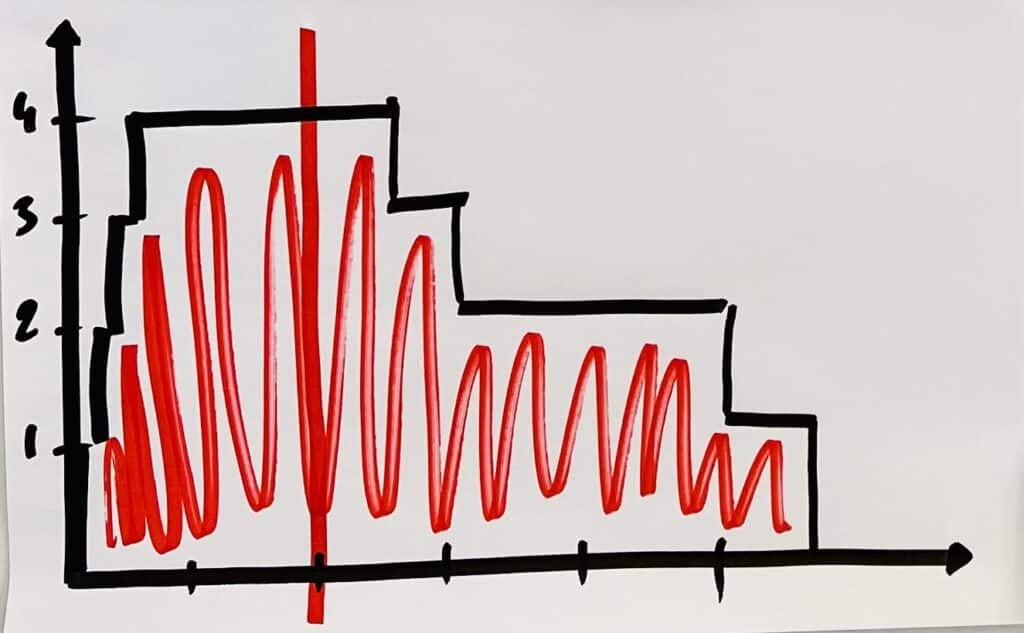
On étudie ici le système de production dans son ensemble comme un zoom du chronogramme précédent
En abscisse, on a toujours le temps avec les mêmes graduations de 10 secondes que sur le chronogramme. Cela nous facilitera l’étude.
En ordonnée, on retrouve le nombre de prénoms traités par le système. Attention à ne pas confondre avec le numéro du prénom comme évoqué précédemment.
Voici comment tracer ce graphe :
| Fonctionnement (Entrée) | Fonctionnement (Sortie) |
|---|---|
| À chaque fois qu’un prénom est commencé, le graphe monte de 1. | À chaque fois qu’un prénom est terminé, le graphe descend de 1. Note : ce n’est pas forcément le premier commencé qui sera terminé en premier. On voit ici que c’est le 2ème qui a terminé en premier. |
Liens avec le chronogramme
Placer le chronogramme juste au-dessus aide à reporter les mesures plus facilement.
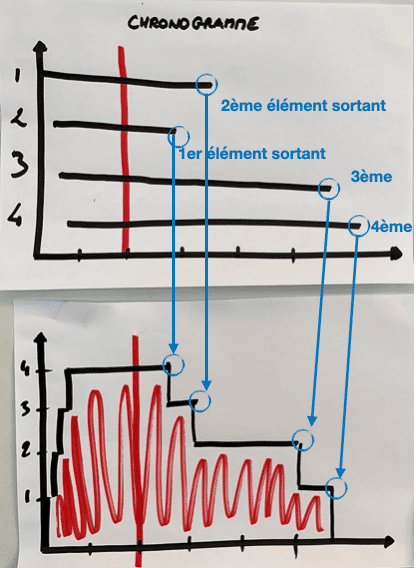
Bon, mes yeux ont eu un peu de mal sur le report du 3ème et du 4ème sortant mais vous comprenez l’idée n’est-ce pas ? C’est une des limites du tracé à la main ! 🙂
Après avoir tracé cela, on est content on a un visuel. Je demande ensuite aux participants ce à quoi cette aire coloriée en rouge correspond selon eux. Après quelques échanges, je leur partage que :
Cela correspond au coût engendré par le système de production.
En effet, c’est le temps passé à travailler sur une tâche et comme l’adage le dit : « le temps c’est de l’argent ! ». 🙂
Maintenant, on ne peut vraiment donner de sens à ce graphe qu’en le comparant à celui que l’on aura dans le tour suivant.
Diagramme de flux cumulé
Le diagramme de flux cumulé correspond au graphe ci-dessous.
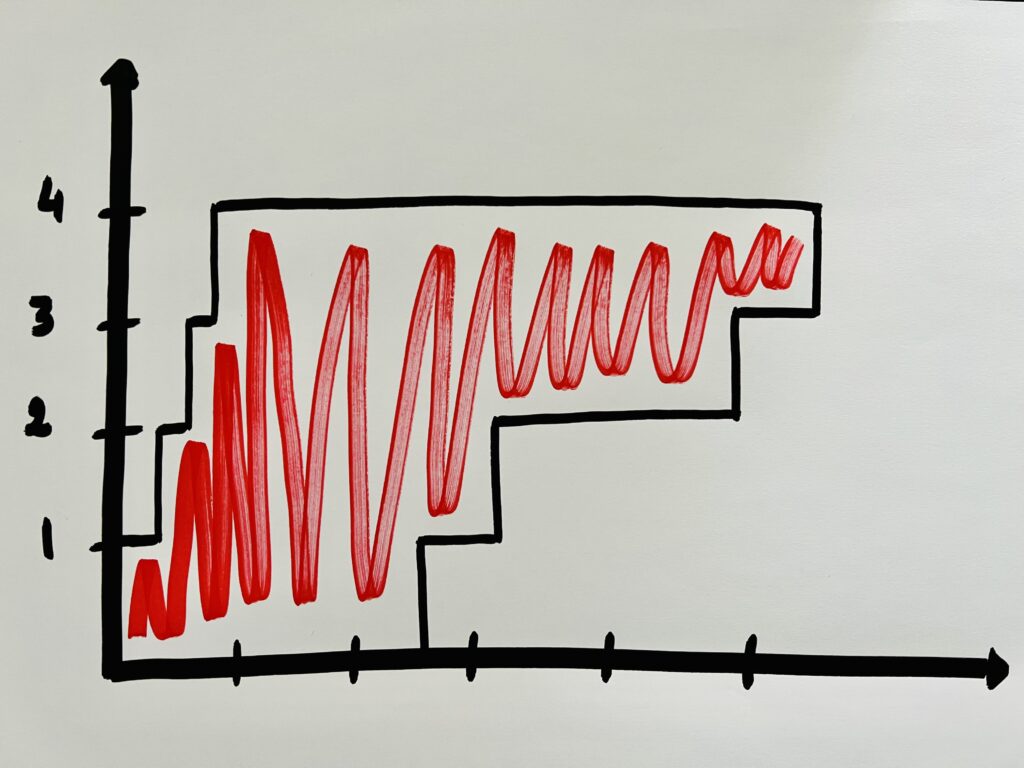
Pour mieux comprendre sa construction, il faut imaginer que l’on suit 2 éléments avec 2 courbes différentes. En effet, dans le graphe précédent on suivait le nombre d’éléments dans le système. C’est pourquoi lorsqu’un élément entre on incrémente de 1 et lorsqu’un élément sort on décrémente de 1.
Ici, lorsqu’un élément entre dans le système on incrémente la première courbe de 1. Lorsqu’un élément sort du système, on incrémente la seconde courbe de 1. On verra ainsi mieux le côté « cumulatif » du diagramme ».
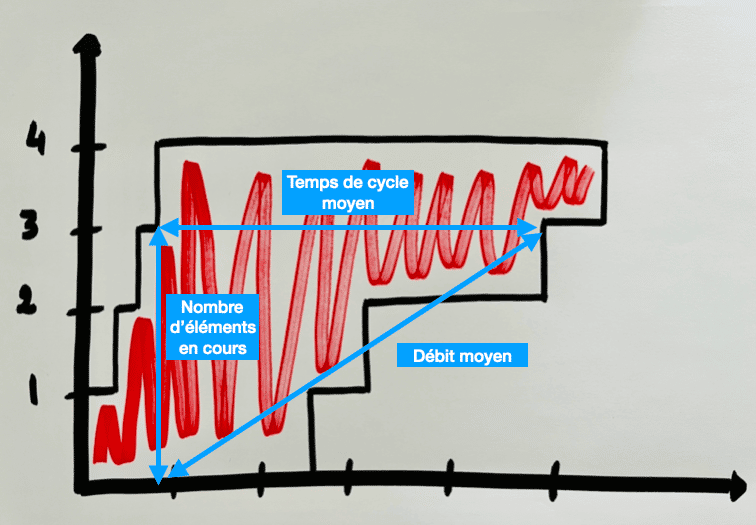
Le diagramme de flux cumulé nous donne un certain nombre d’informations à un instant t :
| Information | Valeur |
|---|---|
| Nombre d’éléments en cours | 3 |
| Temps de cycle moyen (approx.) à partir de cet instant | Près de 40 secondes (ce qui se révèle avéré pour le 4 ème élément sortant) |
| Débit moyen (approx.) | 3 éléments / 40 secondes |
Maintenant, ce que l’on cherche principalement à observer avec le diagramme de flux cumulé est la tendance des 2 courbes d’entrée et de sortie :
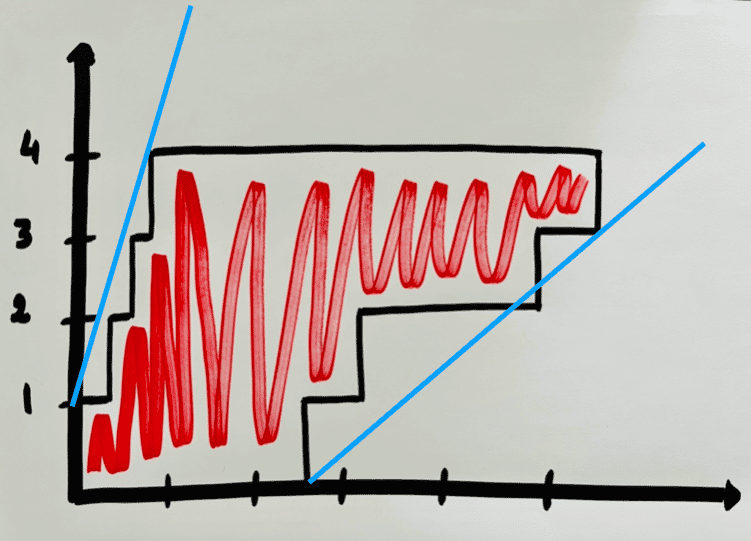
On voit ici que les courbes s’éloignent l’une de l’autre, cela signifie que l’encours augmente. Il y a donc plus d’éléments qui rentrent que d’éléments qui sortent. Cela est donc un signal d’alerte à prendre en compte pour éviter de trop surcharger le système.
C’est un des éléments clé de différence avec le graphe du système de production 🙂
Debriefing Tour 1
J’en profite donc pour faire un petit débriefing de ce premier tour en demandant au scribe puis aux clients comment ils se sont sentis pendant l’exercice.
Voici quelques exemples de ce qui peut se dire :
| Scribe | Clients |
|---|---|
| « Stressant » | « On a l’impression de ne faire qu’attendre » |
| « Pas de vision d’ensemble » | « En plus, on doit dire ce qu’il faut faire à chaque fois si on veut être sûr qu’il ne se trompe pas » |
| « On ne sait pas vraiment quand ça se termine car on est plus préoccupé à switcher » | « C’est usant » |
| « Je savais plus trop où j’en étais » | « On a l’impression qu’on ne s’occupe pas vraiment de nous » |
En d’autres termes :
Personne n’est satisfait.
On passe alors au second tour ! 🙂
Partie 3 : Tour 2 – Mono-tâche
Pour ce second tour, je m’adresse de nouveau au scribe :
Tu viens de changer d’entreprise et cette dernière a une stratégie quelque peu innovante. C’est la satisfaction client avant tout ! Il est donc fondamental de s’en occuper du début jusqu’à la fin.
Les règles sont assez simples : le scribe termine chaque prénom avant de commencer le suivant.
Je demande à chaque client de changer de prénom pour donner un peu de suspense et puis je relance l’exercice.
Comparons un peu les résultats.
Chronogramme

Ce second tour se déroule particulièrement rapidement. Quelques détails méritent cependant que l’on s’y attarde.
- La durée de l’exercice est inférieure à 30 secondes cette fois-ci. On a donc multiplié par 2 l’efficacité de production par rapport au tour précédent.
- certains prénoms ont commencé bien plus tard qu’au premier tour mais ont terminé plus tôt.
Diagramme de flux cumulés
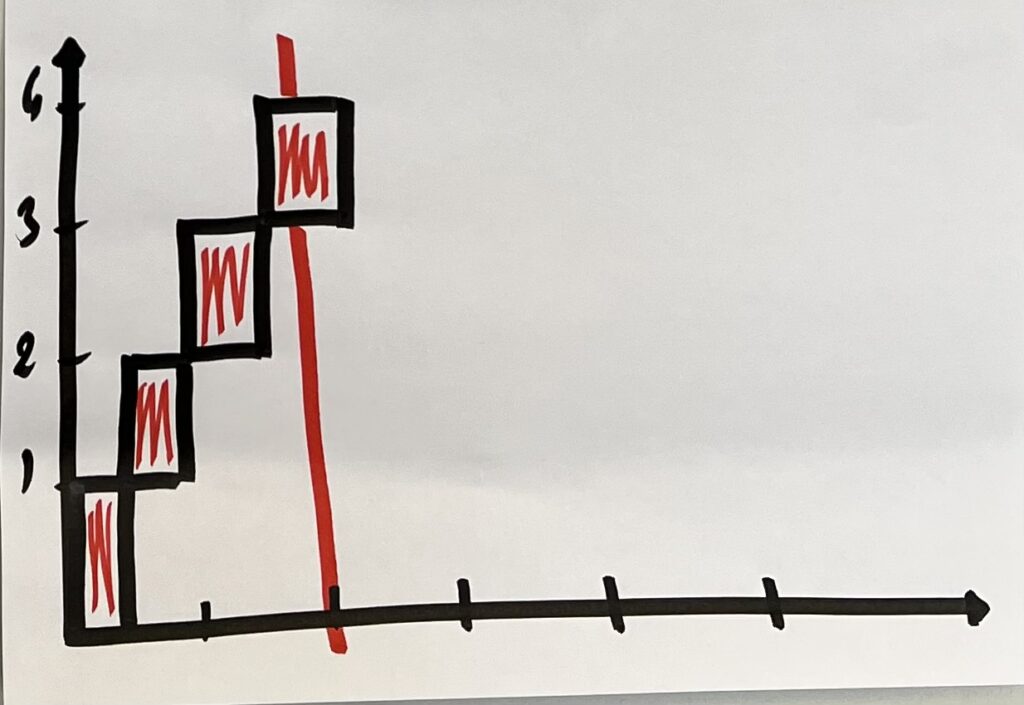
Généralement, ici c’est la stupéfaction. On a beau sentir que le tour était plus efficace, le voir amplifie l’impact : d’autant plus lorsqu’on le compare au tour précédent.
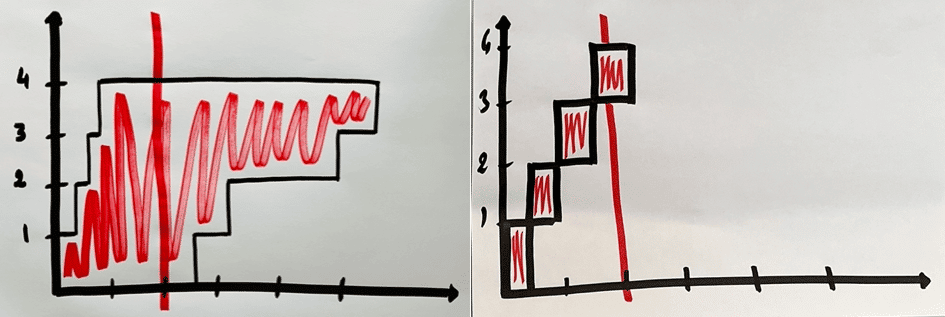
On peut alors débriefer sans trop de difficultés avec les participants en leur demandant quels liens ils font avec leur quotidien et surtout ce qui les empêche aujourd’hui d’aller vers la seconde stratégie.
Pour appuyer d’autant plus, on peut également tracer la tendance pour le CFD de ce tour :
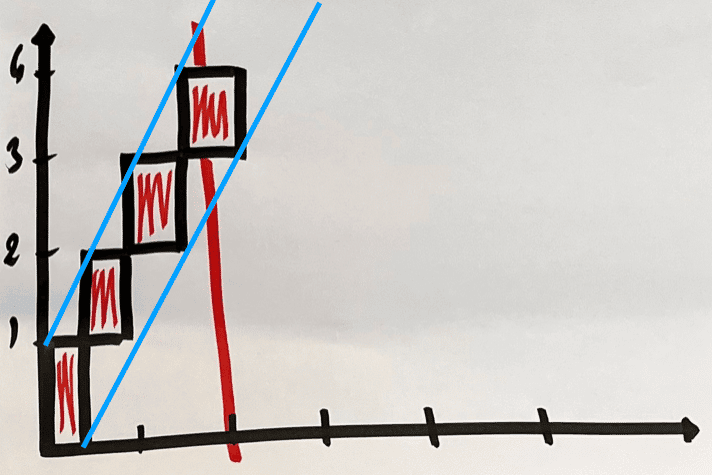
Les 2 courbes sont proches d’être parallèles. Cela signifie que le nombre d’éléments entrants est proche du nombre d’éléments sortants. On peut ainsi considéré que notre système est fiable et l’on peut commencer à parler de prédictibilité 🙂
Débriefing Tour 2
Je demande au scribe comment il a vécu ce tour et généralement la réponse est du type :
C’était plus confortable.
En questionnant un peu plus sur le pourquoi, on se rend compte qu’à la différence du premier tour, c’est le scribe qui est en contrôle du flux de demandes. Souvent même, il signale par un « Top ! » ou un « Suivant ! » le démarrage du prénom suivant. Il travaille alors au rythme adapté à sa capacité à faire.
Lorsque l’on pose la question aux clients, les réponses sont du type :
On sent que l’on s’occupe vraiment de nous. On peut même gérer les soucis de qualité en temps réél.
Un élément vient s’ajouter à cela et c’est là que l’on va utiliser notre curseur des 20 secondes :

Dans le Tour 1, à 20 secondes, rien n’est terminé et le coût ne fait qu’augmenter. Cela peut générer du stress pour les clients et cela ne donne aucune visibilité sur une potentielle date de fin.
Dans le Tour 2, à 20 secondes, 3 éléments sont déjà sortis avec une certaine régularité. On peut donc plus facilement espérer que le 4ème sorte également dans ce rythme. Cela donne de la visibilité aux clients sur une potentielle date de fin et cela aide à patienter plus longuement si l’on sait que le système est fiable.
Une remarque qui émerge à ce moment là est souvent :
Oui, mais les clients n’ont pas toujours la visibilité des uns sur les autres comme dans l’exercice !
C’est tout à fait vrai. Cependant, vous en tant que système de production aurez les métriques qui vous permettront de pouvoir communiquer avec vos clients. C’est là tout l’intérêt des métriques telles que le Lead Time mesurant le temps de réalisation d’un élément de bout en bout d’un processus ! 🙂
Une remarque qui émerge souvent en fin d’atelier :
Il faudrait le faire aux managers !
Je pense qu’effectivement cela pourrait être une bonne idée. Malheureusement, je pense que c’est la strate tout en haut qu’il faudrait réussir à atteindre. En effet, j’ai eu l’occasion de faire l’exercice à des managers d’une grande entreprise française et vous savez ce qu’ils m’ont dit en fin d’atelier ?
Il faudrait le faire à nos managers !
Plaisanteries mises à part, commençons là où on le peut et c’est déjà ça 🙂
Facteurs impactant le temps ?
Pour terminer, je retourne sur l’espace des facteurs impactant le temps pour préciser que :
Tous les éléments évoqués ont effectivement un impact sur le temps mais moins que le multi-tâches.
Je rajoute ensuite un élément autour de l’estimation de temps initiale.
Lorsqu’on nous demande d’estimer quelque chose, on part du principe qu’on ne fera que ça et sans être interrompu. Quand est-ce que cela arrive ?
Vous imaginez bien la réponse 🙂
Je conclus enfin en reprenant les temps du tour 2 qui sont effectivement proches de l’estimation initiale.
Conclusion
Le Jeu des Prénoms est un atelier extrêmement puissant pour aborder le sujet de l’efficacité opérationnelle et notamment du multi-tâche. Il nécessite peu de matériel et est donc facile à dégainer 🙂
Les participants sont généralement marqués visuellement par les graphiques et peuvent difficilement remettre en cause les résultats car ils les ont eux-mêmes obtenus. C’est une grande force des exercices où l’on effectue des mesures car on peut ensuite facilement s’appuyer dessus pour débriefer et en tirer des apprentissages. Le Penny Game en est un autre exemple.
Enfin, un grand merci à Henrik et Alfred pour ces inspirations toujours de grande qualité ! 🙂







3 réponses
Passionnant ! Merci pour cette belle découverte que j’aimerai faire vivre à mon équipe !
Le second CFD me semble faux. Comme le scribe traite une tâche à la fois, on devrait avoir une « barre » de 1 de hauteur plutôt : le scribe écrit un nom on augmente de 1. Il termine le nom on diminue de 1 et de suite il enchaine sur le second nom, on augmente de 1, etc.
Cela permettra aussi d’aborder la limite d’encours qui ici, avec un scribe, est égal à 1. La boucle est bouclée en comprenant que cette limite est visible avec le second CFD.
Encore merci pour vous article toujours aussi intéressant à lire et à pratiquer !
Bonjour Benoît,
Merci pour ton message. Il y a en fait 2 erreurs de ma part, mea culpa !
La description que je fais pour construire le CFD est en fait mauvaise. En effet, en suivant cette instruction, ce que l’on construit n’est pas un CFD mais un zoom du chronogramme (merci Alfred). Cela nous permet néanmoins toujours d’observer le coût d’ensemble de la production des prénoms.
Le second graphe CFD est en fait correct (au sens du véritable CFD) car on voit bien le côté « cumulatif » du diagramme. Ainsi à chaque prénom successif on ajoute bien 1 au cumul. Par contre, et comme tu l’as bien remarqué, si l’on reprend l’instruction que j’en avais faite au départ, le graphe devrait plafonner à 1 (car 1 seul élément en cours à la fois) même si cela ne changera pas grand chose au coût global observé.
Je modifie l’article en conséquence et te remercie à nouveau pour ta remarque 🙂
Belle journée.
Olivier